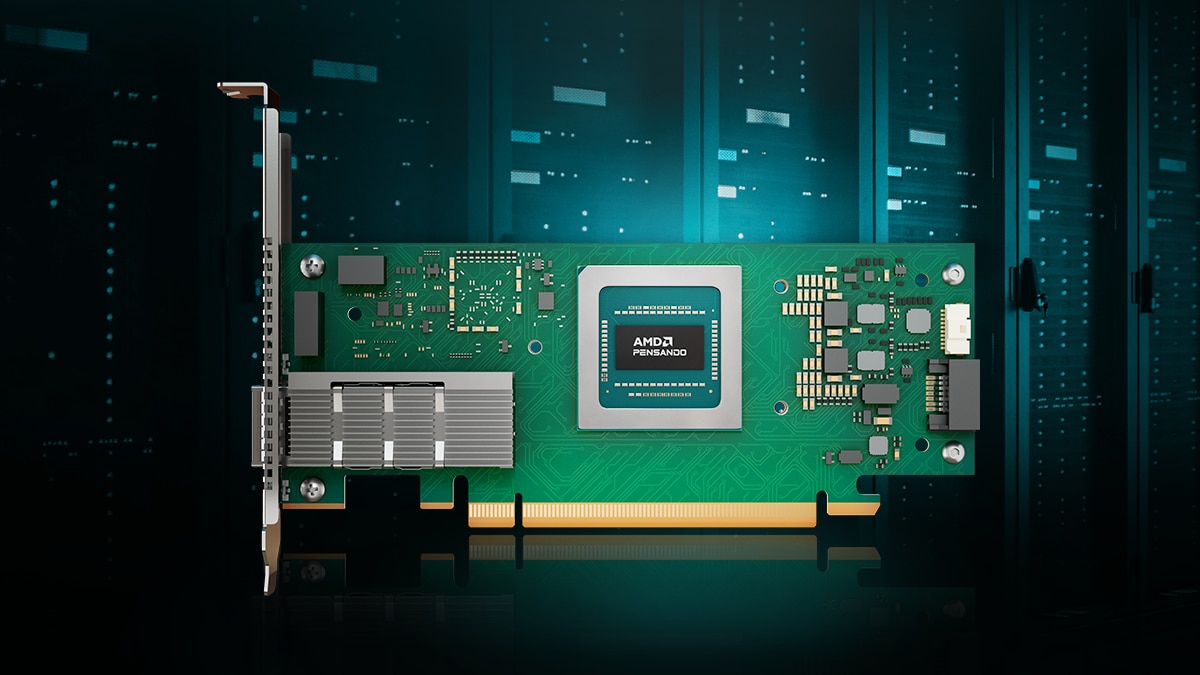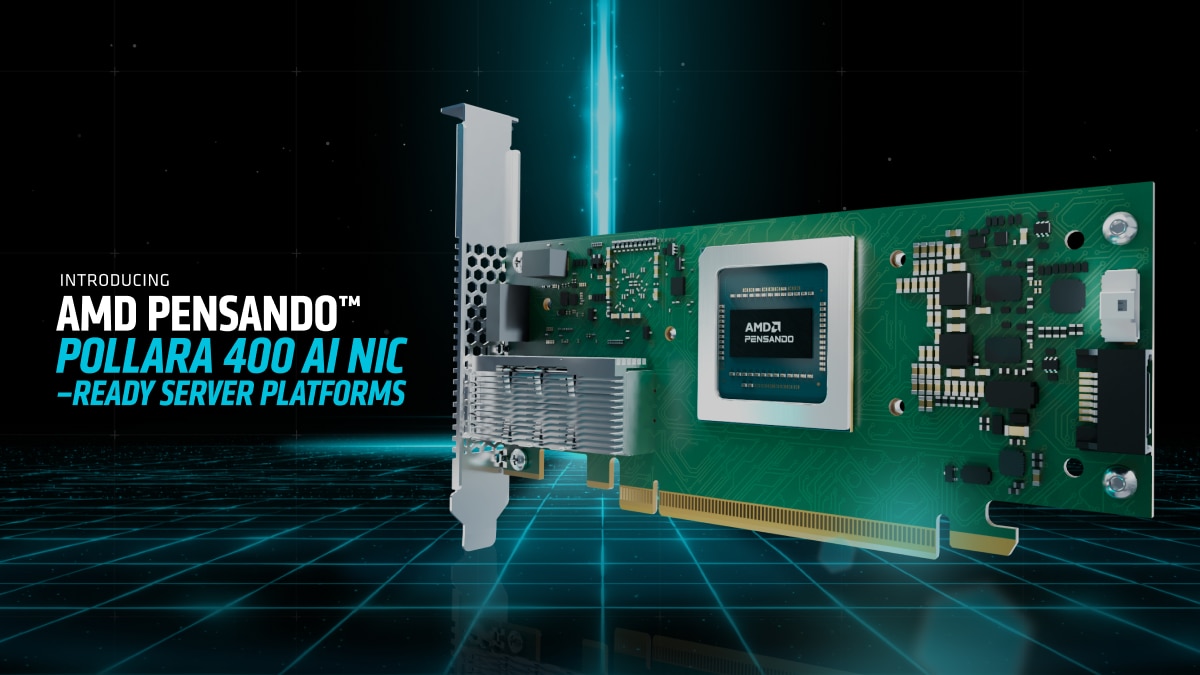The Right CPU can Boost Microsoft SQL Server® Performance and Lower Software Costs
Sep 03, 2025
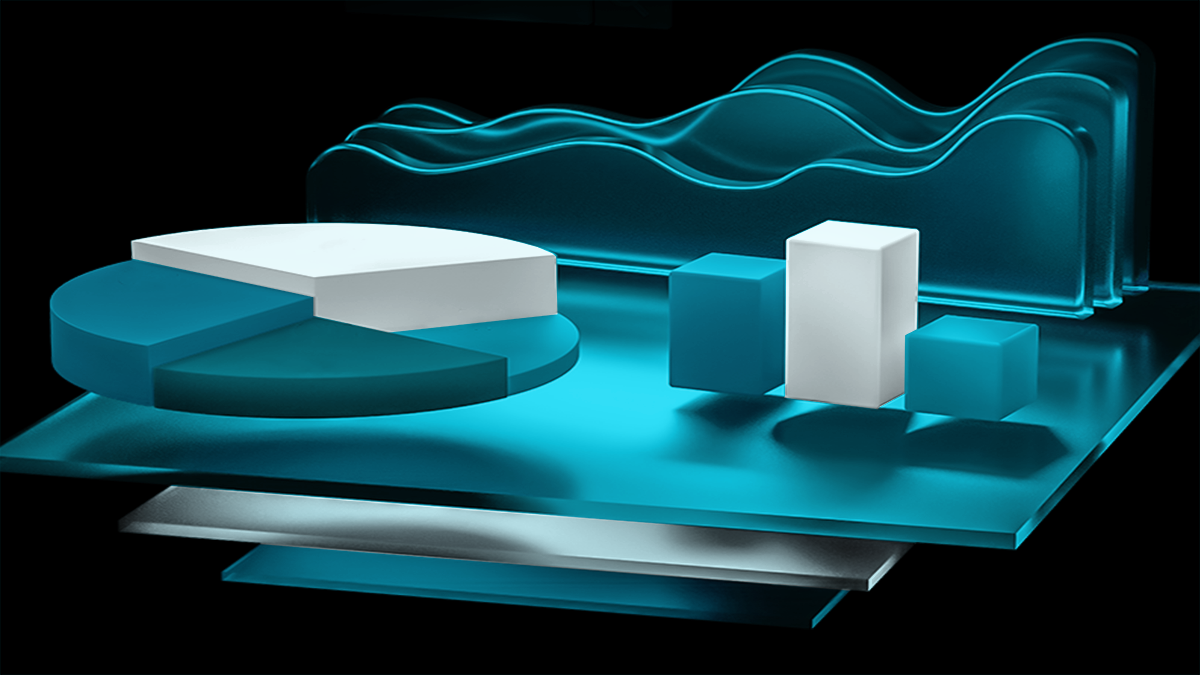
Investing in the right CPUs is a crucial consideration for businesses to achieve significant cost savings while designing their datacenters. By choosing processors that offer exceptional performance and performance per watt, businesses can reduce a variety of costs – power, cooling, cost of operations, and maintenance.
Nowhere is this truer than in the domain of data management, specifically databases and analytics. Software licenses and the associated support costs can be significant and are a major consideration for large organizations. For databases that license by the core, the CPU you choose can reduce the number of licenses you need, which can quickly add up to major savings.
To get a clear idea of how much difference the right CPU can make for database and analytics workloads, let’s consider an example deployment for one of the world’s leading database offerings: Microsoft SQL Server 2022® (MS SQL®).
High-frequency AMD EPYC™ CPUs deliver performance and software savings
MS SQL licenses on a per-core basis, and the costs associated can quickly balloon into a big expenditure. The key to software savings on core-based licensing is to maximize performance and throughput on a per-core basis. AMD makes a class of high-frequency AMD EPYC™ CPUs (all the SKUs that end in “F”) that run at higher speeds — up to 5 GHz — which means each CPU core does more work per hour than a standard CPU core. Choosing high frequency CPUs enables work to be done with fewer cores, resulting in fewer licenses and lower associated costs.
To see how it works and how much we can save, let’s compare performance and software costs for servers with three different CPU configurations:
- A dual-socket server with two 5th Gen Intel Xeon 6544Y CPUs (“Emerald Rapids”) – 32 total cores
- A dual-socket server with two 4th Generation AMD EPYC 9124 CPUs (“Genoa”)
– 32 total cores - A single-socket server with one, high-frequency AMD EPYC 9375F CPU (“Turin” – 32 total cores)
After 10 million analytics queries, we see two very clear trends in our example scenario.
High-frequency processors improve performance without increasing core counts
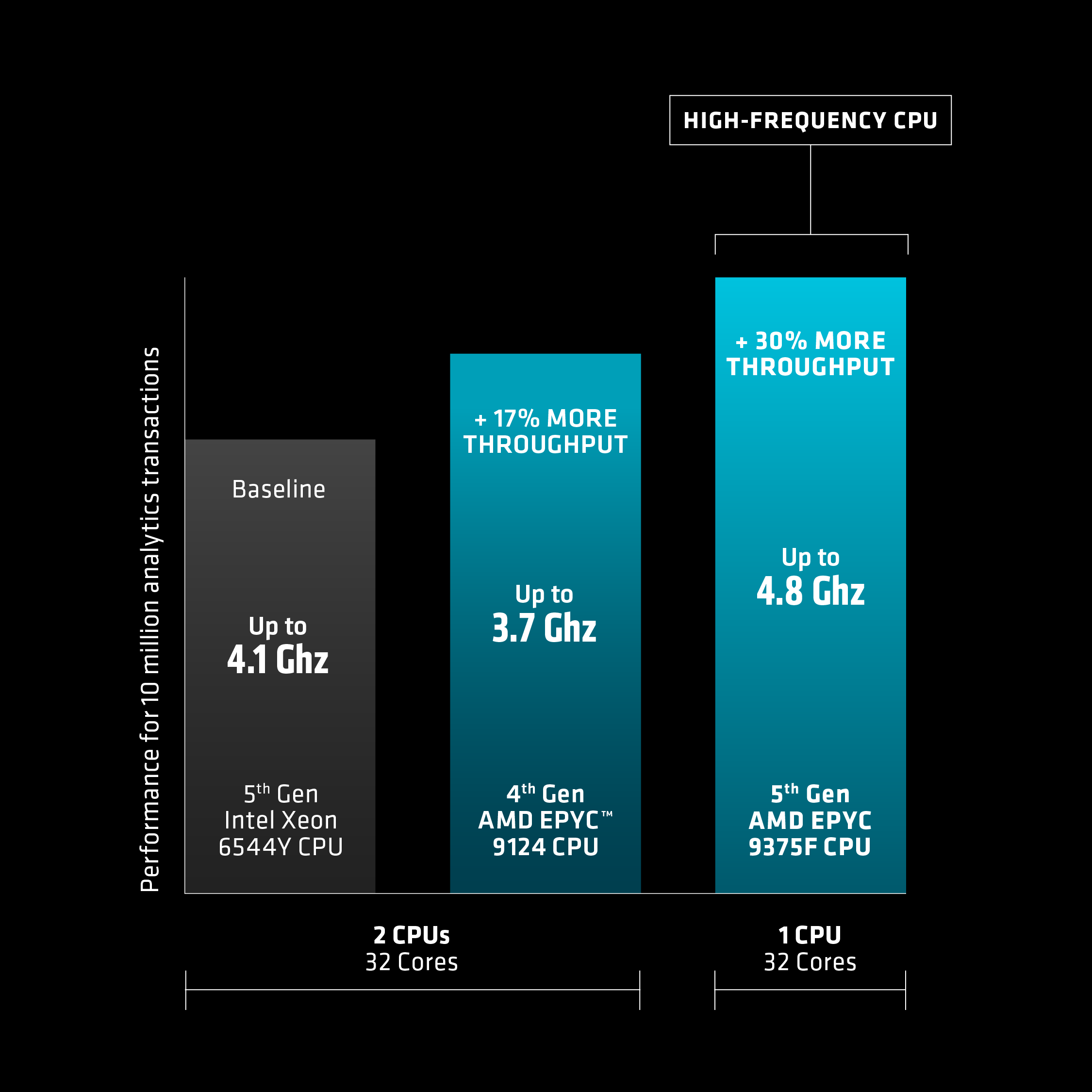
As seen from the chart above, even an older server featuring two 4th Generation AMD EPYC CPUs produces an impressive 17% more query throughput than the 5th Generation Intel Xeon 6544Y CPU system. The high-frequency 5th Generation AMD EPYC 9375F CPU leaps ahead even more, outperforming the Intel Xeon server by up to 30%.1
As performance per core increases, software costs decrease
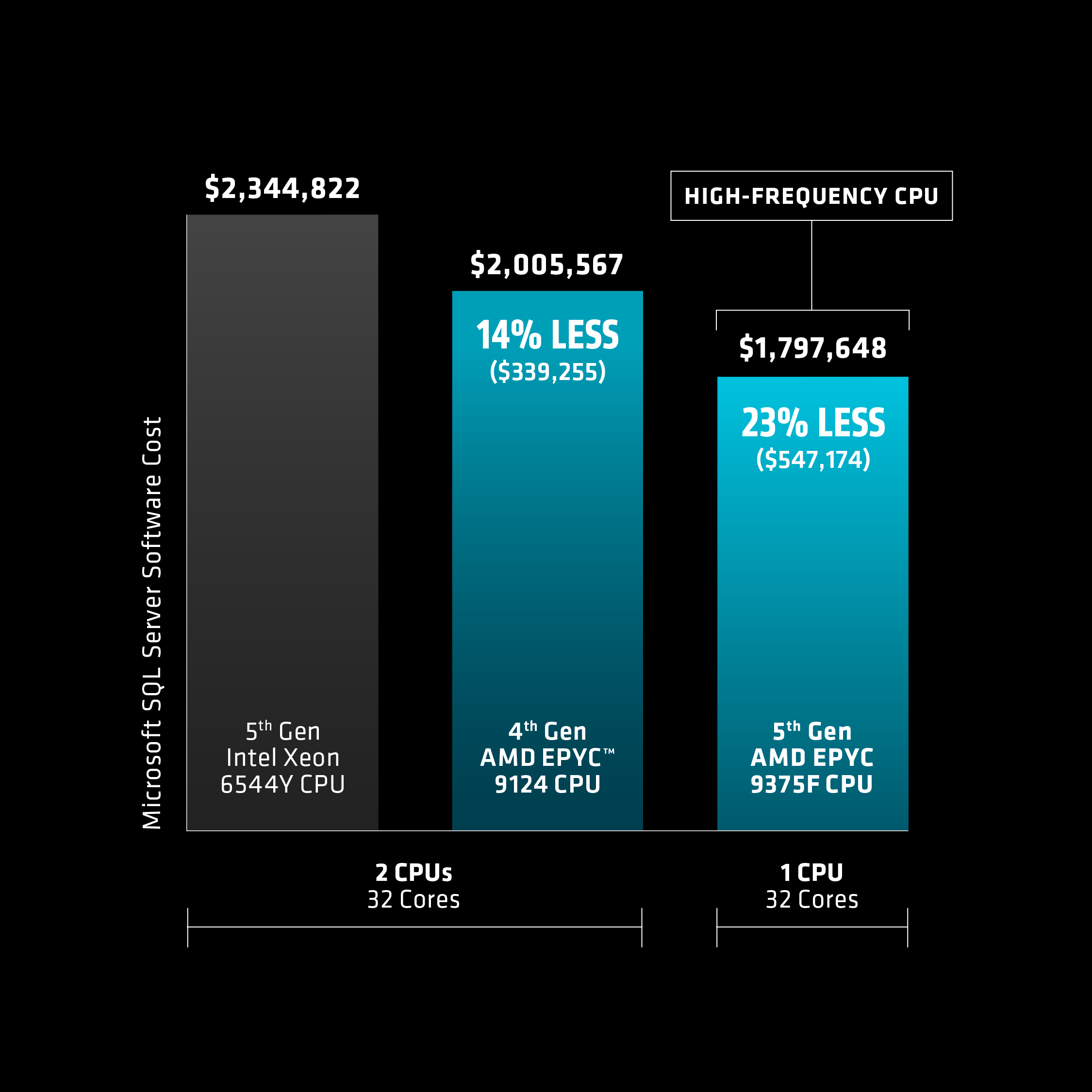
As seen above, the software costs comparison provides a clearer view of the potential savings for this scenario. An older dual-socket 4th Generation AMD EPYC CPU-based platform, released in 2022, reduced licensing fees up to 14% versus the 5th Generation Intel Xeon server, while the higher-frequency, 5th Generation AMD EPYC 9375F CPU cut fees even more, up to 23%, all with the same number of cores per server node. This is tremendous savings while keeping the core count at 32 cores per node. The higher savings are achieved through better performance per core and the resulting consolidation, as fewer EPYC-based servers are needed to reach the same performance. In actual dollars, savings are estimated to be over $547k for the example scenario of executing 10 million queries in an enterprise setting.
For the value-minded who would benefit from even further savings, consider a single-socket server with a 16-core AMD EPYC 9175F CPU. Halving the core count per server can reduce licensing fees up to 37% relative to the 5th Generation Intel Xeon server, which adds up to a remarkable $881k in savings for the same scenario as above. At half the cores per socket, the AMD EPYC 9175F CPU is only 20% slower than the dual-socket 5th Gen Intel Xeon 6544Y CPU-based server. However, downsizing the BOM and saving $881K may be a solid trade-off for many.
Microsoft SQL Server savings are only the beginning
MS SQL isn’t the only software that charges by the core. Oracle Database® and IBM® DB2® use a similar, core-based licensing structure. Beyond databases, VMware®, Nutanix™, and Windows Server® are also licensed by the core. If these applications are a significant part of your data center’s workloads, choosing high-frequency AMD EPYC CPUs can create major savings.
Choosing the right CPU requires analysis, research, and thorough testing. If you need help determining the best CPUs for your workload mix, reach out to AMD or contact a provider in our database partner ecosystem. Together, we can find the right balance of performance, speed, and software savings for your next data center investments.
Thanks to the DEAE team, specifically Bryon Georgson, Sonia Shirwadkar, and Milind Damle for all the benchmark data that was used in this blog.
Footnotes
1. TPC-H analytics workload based on internal AMD measurements as of 6/16/2025. This workload is derived from the TPC-H Benchmark and is not comparable to published TPC-H Benchmark results, as this implementation does not comply with all requirements of the TPC-H Benchmark. Workload configs: SQL Server 2022 CU 11, 32 Core Node, SF3000, TPC-H Kit MSTPCH 2.18.0-2600 1P 32C AMD EPYC 9375F powered production server (32 total cores, 1.5 TB DDR5 5200Mhz Memory, BIOS 0.2.3 X-Rev, SMT=On, Determinism=Power, mitigations=off; OS Microsoft Windows Server 2022 Standard, 10.0.20348 Build 20348, 10 x 3.49TB storage) with 1,346,026 avg QphH@3000 1P 16C AMD EPYC 9175F powered production server (16total cores, 1.5 TB DDR5 5200Mhz Memory, BIOS 0.2.3 X-Rev, SMT=On, Determinism=Power, mitigations=off; OS Microsoft Windows Server 2022 Standard, 10.0.20348 Build 20348, 10 x 3.49TB storage) with 826,781 avg QphH@3000 2P 16C AMD EPYC 9124 powered production server (32 total cores, 1.5 TB DDR5 4800Mhz Memory, BIOS 1.7.2, SMT=On, Determinism=Power, mitigations=off; OS Microsoft Windows Server 2022 Datacenter, 10.0.20348 Build 20348, 3 x 6.9TB and 3 x 3.4TB storage) with 1,206,427 avg QphH@3000 Versus 2P 16C Intel Xeon 6544Y powered production server (32 total cores, 3 TB DDR5 5600Mhz Memory, BIOS ESE124B-3.11, SMT=On, mitigations=off; OS Microsoft Windows Server 2022 Datacenter, 10.0.20348 Build 20348, 9 x 3.49TB storage) with 1,031,925 avg QphH@3000
Estimated licensing costs for running 10M queries
2P Intel Xeon 6544Y platform: $2,344,822
2P AMD EPYC 9124 platform: $2,005,657
1P AMD EPYC 9375F platform: $1,797,648
1P AMD EPYC 9175F platform: $1,463,313
Microsoft SQL Server 2022 license pricing information: $15,123 per 2 core pack, source:
https://www.microsoft.com/en-us/sql-server/sql-server-2022-pricing. Pricing as of 5/2/2025. Results may vary due to factors including system configurations, software versions and BIOS settings. (9xx5-221)
© 2025 Advanced Micro Devices, Inc. All rights reserved. AMD, the AMD Arrow logo, EPYC, and combinations thereof are trademarks of Advanced Micro Devices, Inc. in the United States and other countries. Microsoft SQL Server and Windows Server are registered trademarks of Microsoft Corporation in the US or other jurisdictions. TPC and TPC Benchmark are trademarks of the Transaction Processing Performance Council. Other product names used herein are for identification purposes only and may be trademarks of their respective owners. Certain AMD technologies may require third-party enablement or activation. Supported features may vary by operating system. Please confirm with the system manufacturer for specific features. No technology or product can be completely secure.
1. TPC-H analytics workload based on internal AMD measurements as of 6/16/2025. This workload is derived from the TPC-H Benchmark and is not comparable to published TPC-H Benchmark results, as this implementation does not comply with all requirements of the TPC-H Benchmark. Workload configs: SQL Server 2022 CU 11, 32 Core Node, SF3000, TPC-H Kit MSTPCH 2.18.0-2600 1P 32C AMD EPYC 9375F powered production server (32 total cores, 1.5 TB DDR5 5200Mhz Memory, BIOS 0.2.3 X-Rev, SMT=On, Determinism=Power, mitigations=off; OS Microsoft Windows Server 2022 Standard, 10.0.20348 Build 20348, 10 x 3.49TB storage) with 1,346,026 avg QphH@3000 1P 16C AMD EPYC 9175F powered production server (16total cores, 1.5 TB DDR5 5200Mhz Memory, BIOS 0.2.3 X-Rev, SMT=On, Determinism=Power, mitigations=off; OS Microsoft Windows Server 2022 Standard, 10.0.20348 Build 20348, 10 x 3.49TB storage) with 826,781 avg QphH@3000 2P 16C AMD EPYC 9124 powered production server (32 total cores, 1.5 TB DDR5 4800Mhz Memory, BIOS 1.7.2, SMT=On, Determinism=Power, mitigations=off; OS Microsoft Windows Server 2022 Datacenter, 10.0.20348 Build 20348, 3 x 6.9TB and 3 x 3.4TB storage) with 1,206,427 avg QphH@3000 Versus 2P 16C Intel Xeon 6544Y powered production server (32 total cores, 3 TB DDR5 5600Mhz Memory, BIOS ESE124B-3.11, SMT=On, mitigations=off; OS Microsoft Windows Server 2022 Datacenter, 10.0.20348 Build 20348, 9 x 3.49TB storage) with 1,031,925 avg QphH@3000
Estimated licensing costs for running 10M queries
2P Intel Xeon 6544Y platform: $2,344,822
2P AMD EPYC 9124 platform: $2,005,657
1P AMD EPYC 9375F platform: $1,797,648
1P AMD EPYC 9175F platform: $1,463,313
Microsoft SQL Server 2022 license pricing information: $15,123 per 2 core pack, source:
https://www.microsoft.com/en-us/sql-server/sql-server-2022-pricing. Pricing as of 5/2/2025. Results may vary due to factors including system configurations, software versions and BIOS settings. (9xx5-221)
© 2025 Advanced Micro Devices, Inc. All rights reserved. AMD, the AMD Arrow logo, EPYC, and combinations thereof are trademarks of Advanced Micro Devices, Inc. in the United States and other countries. Microsoft SQL Server and Windows Server are registered trademarks of Microsoft Corporation in the US or other jurisdictions. TPC and TPC Benchmark are trademarks of the Transaction Processing Performance Council. Other product names used herein are for identification purposes only and may be trademarks of their respective owners. Certain AMD technologies may require third-party enablement or activation. Supported features may vary by operating system. Please confirm with the system manufacturer for specific features. No technology or product can be completely secure.


